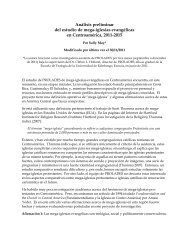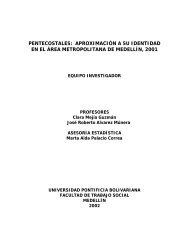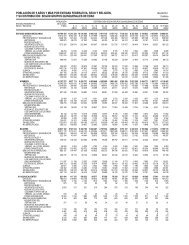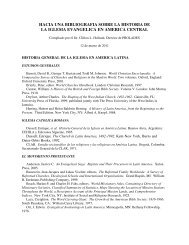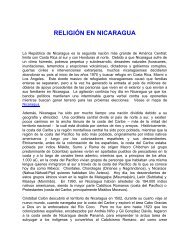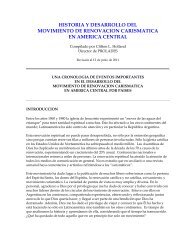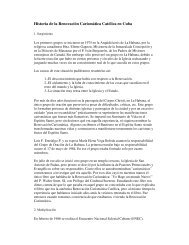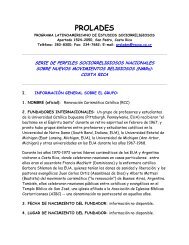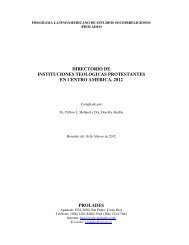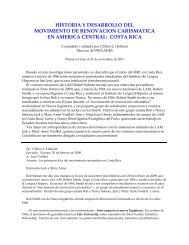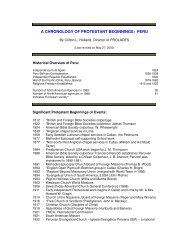belize, 1980 - Prolades.com
belize, 1980 - Prolades.com
belize, 1980 - Prolades.com
You also want an ePaper? Increase the reach of your titles
YUMPU automatically turns print PDFs into web optimized ePapers that Google loves.
were eager to begin new ministries and occupy new stations across the Spanish borders, but new<br />
recruits for the Belize field were lacking, with the Society unable to even replace those who died,<br />
retired or were transferred for health reasons to other assignments. At this crucial moment that<br />
called for the strengthening of Methodist work in Belize and for advancement into Spanish-speaking<br />
Central America, the Wesleyan Methodist Missionary Society experienced a serious crisis in the<br />
homeland that drastically lowered its in<strong>com</strong>e and curtailed all plans and hopes for advance. This<br />
crisis was known as the Missionary Controversy of 1888-1890.<br />
In spite of these handicaps, several new workers were recruited and contributed significantly<br />
to the advancement of the Gospel in Belize. Joseph Nowell, known as one of the finest missionaries<br />
ever sent to the Caribbean, served the Belize field for six years, from 1888 to 1894, chiefly<br />
among the Black Carib tribesmen on the Stann Creek Circuit. Nowell, however, was forced by<br />
health problems to return to England. During the later 1890s, an able, colored schoolmaster of<br />
strong evangelical convictions, Hezekiah McField, became an itinerant Methodist preacher and had<br />
an effective ministry among the back-country woodsmen, who were notably difficult to reach with the<br />
Gospel. Although hindered by financial problems and internal turmoil during the 1890s, the Belize<br />
Mission showed a slight gain in membership, increasing by 150 members between 1891 and 1900.<br />
Stability and progress were again resumed under the leadership of James William Lord, who<br />
returned to Belize in 1900 and became Chairman of the District. During his first term of service on<br />
the same field, from 1881-1889, Lord acquired a good <strong>com</strong>mand of Spanish and earned a good<br />
reputation because of his hard work on the Stann Creek Circuit, his estimable character, and his<br />
sound judgment and knowledge on the field. With his return to Belize, the condition of the District<br />
greatly improved. The new atmosphere of optimism and enthusiasm was aided by the official visit of<br />
Secretary Perkins from the Society in London, who inspected the state of affairs of the District in the<br />
spring of 1900, shortly before Lord's arrival. Consequently, misunderstandings were resolved,<br />
demoralizing policies abandoned, and the finances of the District were revised and guaranteed by<br />
more adequate budgeting by the Society, which generated new hope among missionary staff and<br />
local church leaders.<br />
Although Lord was encouraged to make bold plans for extension into Central America and<br />
for the reoccupying of the San Pedro Sula field that had been abandoned, he had little time to<br />
ac<strong>com</strong>plish his desires and few assistants to bridge the gap. Lord had brought two new<br />
missionaries with him from England in 1990, but shortly after their arrival, two other missionaries on<br />
the field were forced to return home due to broken health. Lord himself, although a seasoned<br />
veteran, had to abandon his labors in Belize and return to England in 1911 because of poor health.<br />
His two promising young assistants, H. Donald Spencer and Benjamin Chicken, both died<br />
simultaneously in 1912, thereby delaying all hope of advancement in the Belize Mission or in Central<br />
America.<br />
In 1913, the British Honduras District of the Wesleyan Methodist Church numbered<br />
about 2,000 church members and was served by nine ministers, including three native Belizeans.<br />
Wesley College, which had been closed for some years previously due to staff shortages and<br />
financial problems, was reopened in 1907, following the appointment of a qualified schoolmaster.<br />
Education always held an important place in early Methodist missionary endeavors, which resulted<br />
in the founding of a number of schools, some dating back to the 1830s. Wesley College, founded<br />
in 1881, is the oldest secondary school in Belize.<br />
The "Honduras District" historically included both British Honduras and the Republic of<br />
Honduras, which is predominantly Spanish-speaking. However, Methodist work in Spanish<br />
Honduras was centered in the Bay Islands and in a few towns along the northern coast where the<br />
English-speaking Creole population is concentrated. The history and development of Methodist<br />
47



